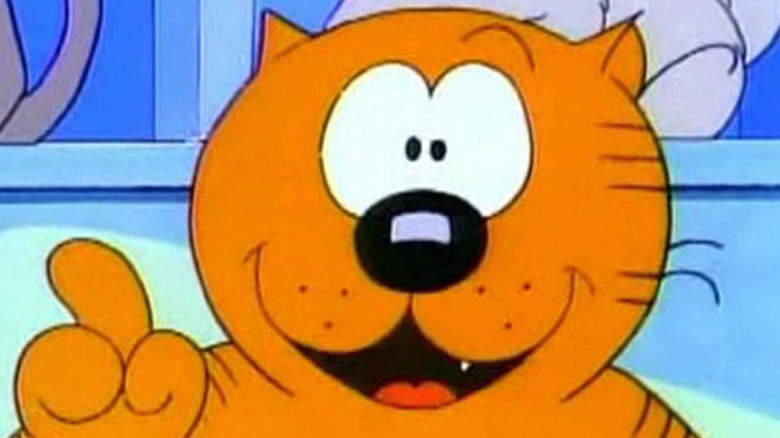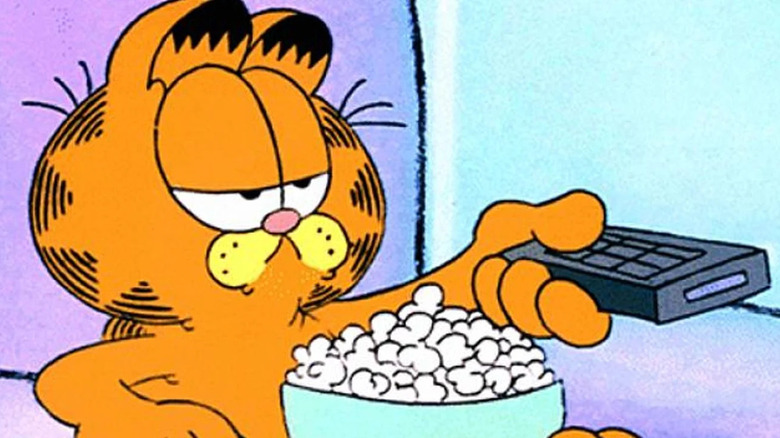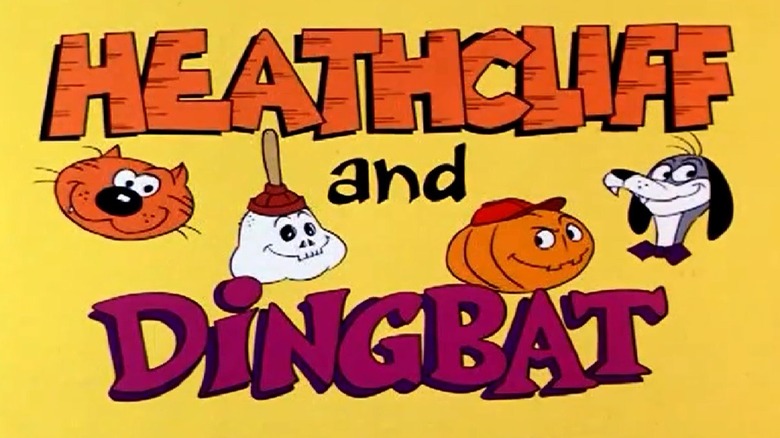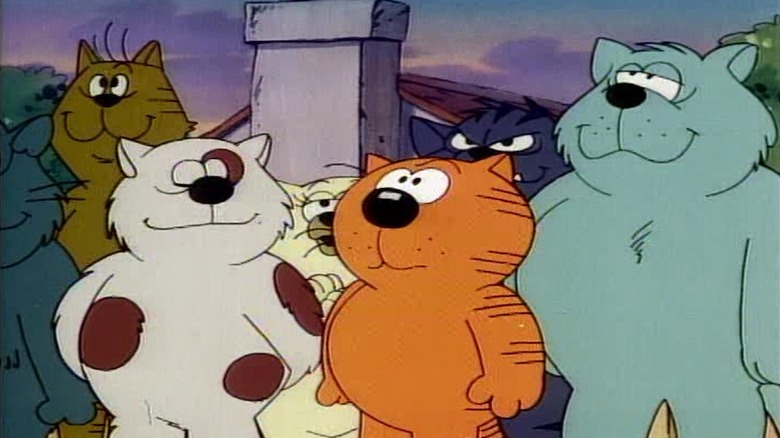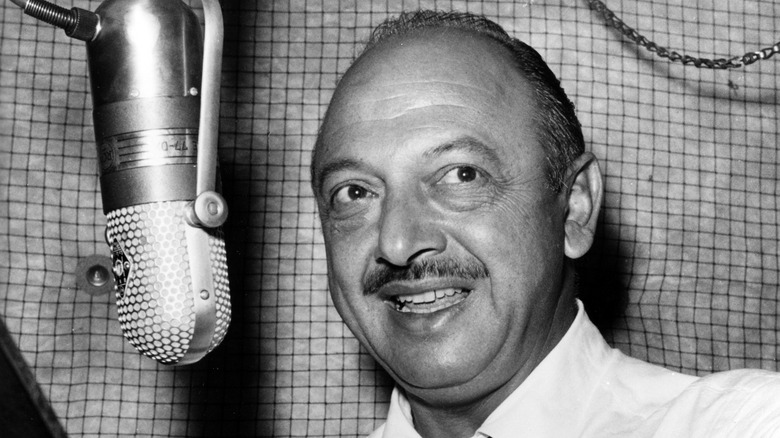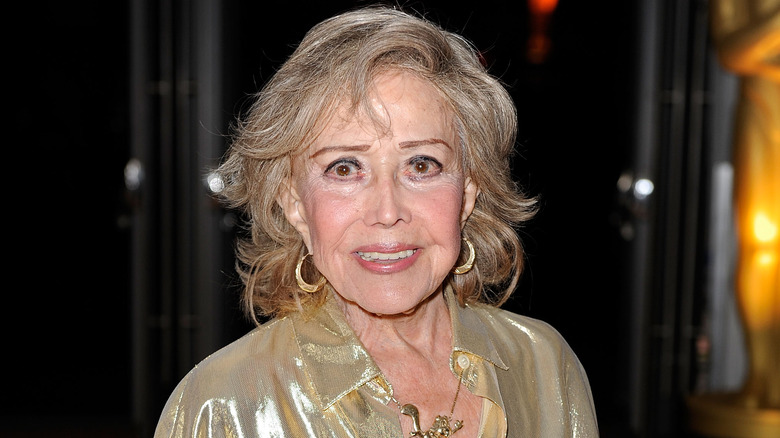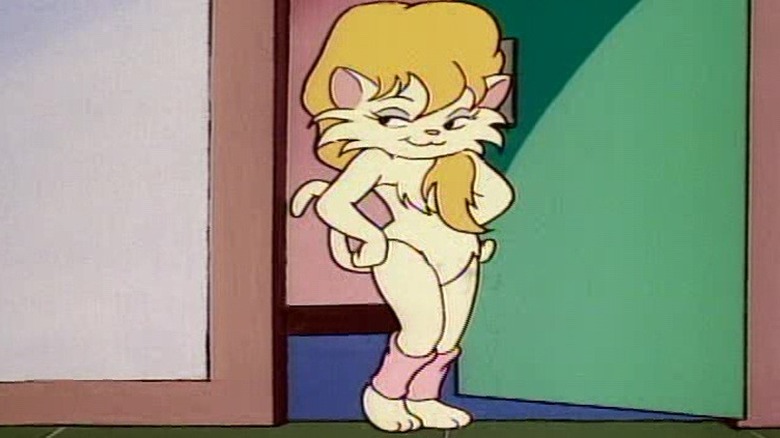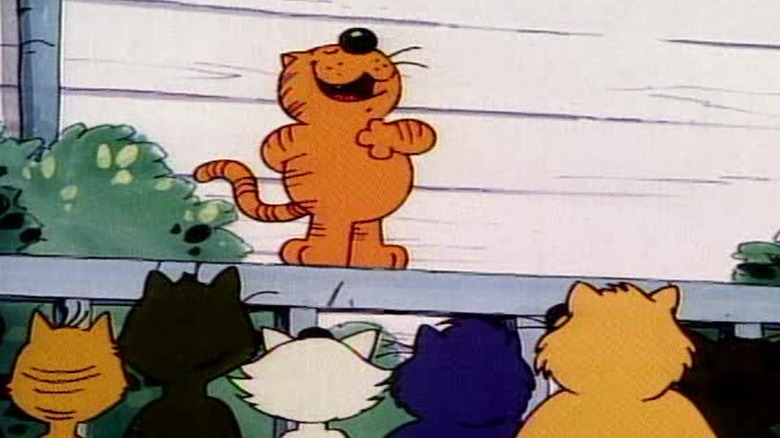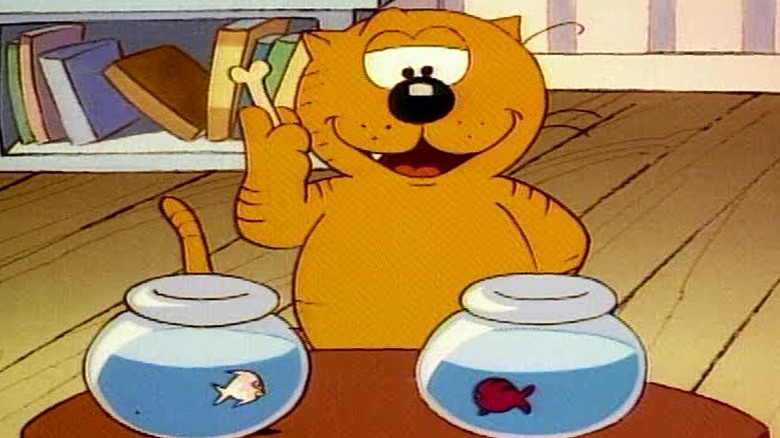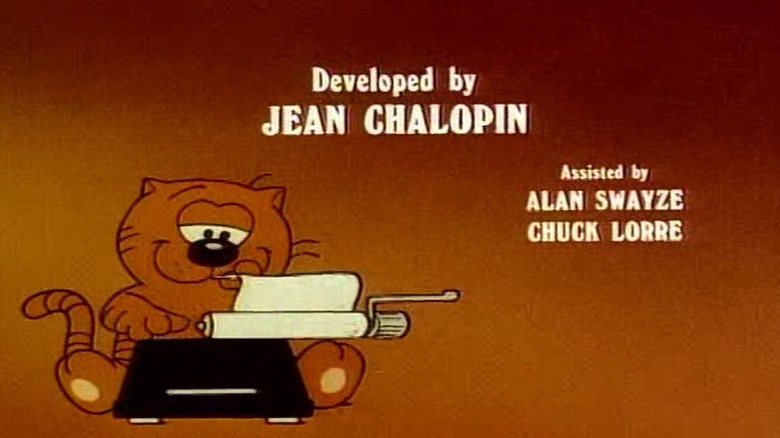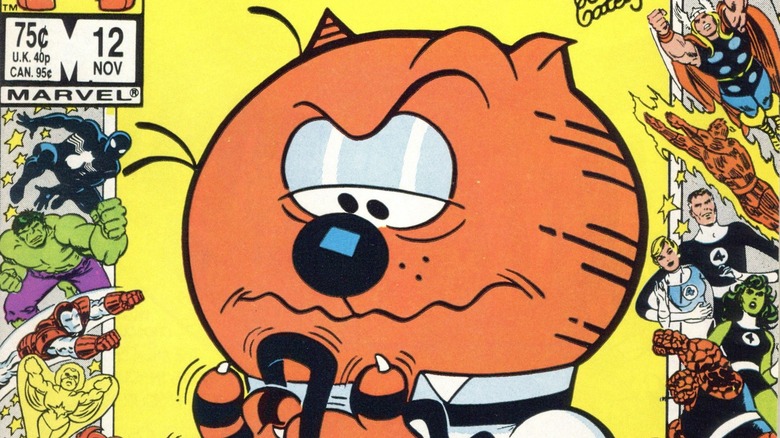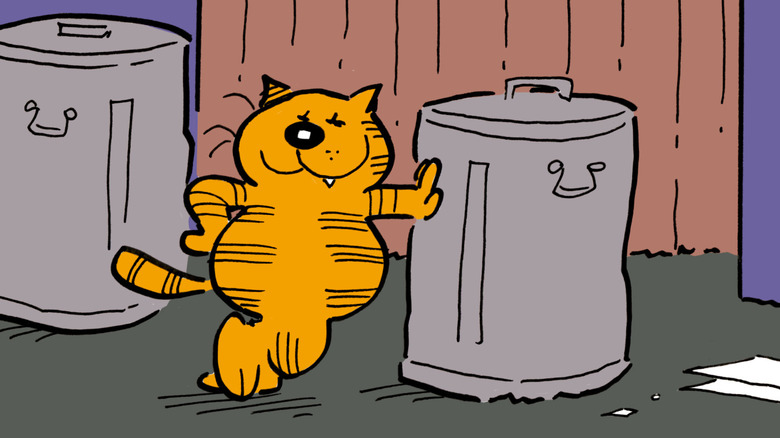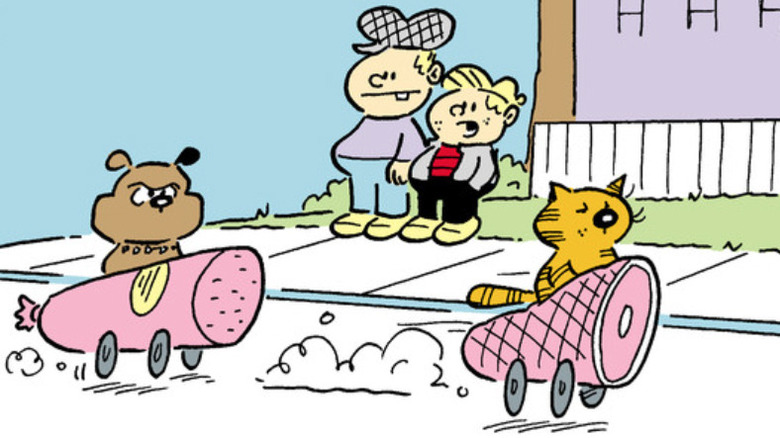Things Only Adults Notice In Heathcliff
When it comes to orange cartoon cats with an affinity for food, two names come to mind. Garfield may be more commonly known these days, but he was presaged — not just in the newspaper comic section, but also on the small screen — by a feline named Heathcliff.
Created by George Gately, Heathcliff debuted in 1973 and has been going strong as a single-panel daily comic strip — with an expanded layout on Sundays — ever since. But Heathcliff has lived a life outside of newspapers as well: He became the star of two different animated series — with three different names! — a long-running comic book at Marvel, and even a big-screen feature with another one in the works at Legendary Pictures. Whatever the medium, though, Heathcliff always finds himself getting into trouble while also standing up for the little guy and often enjoying some delicious garbage along the way.
With the comic strip, now done by Gately's nephew Peter Gallagher, garnering attention for its occasionally surreal nature, many have gone back to look at Heathcliff's early days. In doing so, plenty of elements pop out to an older eye that may have gone unnoticed by kids in the '80s sitting in front of the TV on Saturday mornings. Here's a look at some of the things only adults notice in "Heathcliff."
Heathcliff is not a Garfield ripoff
Many presume that since Garfield is so much more popular, he must have come first, but that's not the case. While both debuted as comic strip stars in the 1970s, Heathcliff bowed first in 1973, with Jim Davis' creation hitting the big time in 1978 after a smaller local strip called "Jon."
Looking at the actual dates — which would have been a nearly impossible task in the 1980s — you also come to realize that even though Garfield has racked up more total hours of television, Heathcliff also beat him to the small screen with a 1980 debut. Though Garfield starred in several animated specials, starting with 1982's "Here Comes Garfield," his show, "Garfield and Friends," would not begin airing until 1988.
Given their physical similarities, it's understandable that the two felines are considered rivals, but Garfield became more of a superstar, starring in cartoon shows running through five different decades, major motion pictures, comic books galore and even getting his own phone. That higher profile for Davis' character means most of us consider him the forerunner, but it's actually Heathcliff who came first.
There were actually three Heathcliff shows
Before we could easily look up every show's history, cast, and schedule, there was a lot more randomness in our viewing. Many youngsters had a favorite channel that they would turn on and have a great time with whatever came on. Between that and the joys of syndication, which resulted in reruns for years after a show ended production, viewers could have a hard time keeping track of what they were watching.
The various "Heathcliff" animated series certainly didn't help alleviate that confusion: Even though the cat was voiced by the same person throughout the decade, he actually starred in three different shows. The first series launched from Ruby-Spears Productions in 1980 and ran for one season as "Heathcliff and Dingbat." While the fine feline fellow carried on his own adventures, the show also featured the antics of Dingbat, a canine vampire, along with his pals Sparerib the skeleton and Nobody, a talking pumpkin. After 13 episodes, the title and format changed to become "Heathcliff and Marmaduke" with the first episode of the second season, making the show a double dip for comic strip fans, though it also only lasted for one season of 13 episodes.
By 1984 the rights had been picked up by DiC, who created two seasons of "Heathcliff and the Catillac Cats" which resulted in 86 episodes split between the orange kitty and Riff Raff, a fellow feline. The pair only ever interacted in the credits of the show even though characters like Hector, Mungo, and Wordsworth interacted with both. Even this series featured some title confusion, though, changing its name to "Cats and Co." when Cadillac took issue with the name. Finally, "Heathcliff: The Movie," which came out in 1986, consists of segments taken from this series, presented as a kind of anthology.
An animal's role in this world is questionable
Kids benefit from an unadulterated imagination and innate sense of wonder. While their brains form and before they learn how the world works, it seems like anything is possible, leading to a beautiful time of creativity and acceptance. Figuring out rules and logic will come later, which has been a huge benefit to cartoon creators over the years. Take the various Heathcliff series, for instance, and think about what it means to be an animal in these shows.
The idea of some animals acting, walking, and talking like humans while others remain more, well, animalistic has been around forever. Just consider how differently Goofy and Pluto act in Disney stories even though they're both dogs.
In the Heathcliff cartoons, the relationships are all over the place. The animals, mostly cats and dogs, can speak to one another clearly, but only meow at humans. However, they still wander around town on two legs while wearing accessories ranging from headphones and roller skates to leg warmers and fashionable hats. The animals even have their own celebrities, like singing star the Great Pussini, but there are also zoos keeping others in cages. It really makes you wonder whether the people of Westfinster are ignoring an obviously sentient and intelligent group living right under their noses.
Heathcliff is voiced by legend Mel Blanc
Without really knowing it, kids in the '80s heard legends plying their craft after school and on Saturday mornings. Classics like "Looney Tunes," "The Flintstones," "The Jetsons," and animated Disney shorts were still in semi-regular rotation, but newer shows like "Heathcliff" also managed to bring in some of the most important voices to ever grace the world of animation. In the case of this particular orange cat, he was brought to audible life by none other than Mel Blanc.
Blanc got his start doing live sound effects and voices on radio shows like "The Jack Benny Program," but he's most famous for providing the voices for Bugs Bunny, Porky Pig, Woody Woodpecker, Daffy Duck, Mr. Spacely, Secret Squirrel, Captain Caveman, and Barney Rubble, among many others. For Heathcliff, the legend developed a tough but lovable character with a distinctive giggle who would sound right at home among the Three Stooges.
According to Donna Christie, who played Iggy and Cleo on "Heathcliff and the Catillac Cats," that second series came to an end because of Blanc's declining health. The last episode aired on December 26, 1986 and Blanc passed away from heart disease on July 11, 1989 after an extended stay in the hospital. With that, Heathcliff became one of Mel Blanc's last new original voices.
More incredible voice talent
As kids, you may have noticed that an animated character sounded familiar without being able to pin down exactly why, but that's much easier for adults. The original Ruby-Spears "Heathcliff" production featured a stacked cast of classic voice actors. You had Mel Blanc, June Foray (Rocky the Flying Squirrel, Disney's Cinderella), Paul Winchell (Dick Dastardly, Gargamel from "The Smurfs"), Don Messick (the original Scooby-Doo, Boo-Boo from "Yogi Bear"), and Frank Welker (the original Fred and the current Scooby-Doo), who went on to voice Garfield himself.
Mel Blanc carried over the voice to "Heathcliff and the Catillac Cats," which added a sense of continuity between the two. That program also included a few familiar voices as well. Danny Wells was known first as Charlie the bartender on "The Jeffersons" and later as Luigi on "The Super Mario Super Show." Fans of "Heathcliff" when it came out, with kids of their own now, might also recognize Derek McGrath's voice from his appearances as Mr. McFeely on "Daniel Tiger's Neighborhood."
However, the real superstar of the series — aside from Blanc, of course — was none other than Peter Cullen, who would pop in for additional voices. Cullen is the modern voice of Winnie the Pooh's pal Eeyore and worked on everything from "Spider-Man and His Amazing Friends" to "Mister T," but is most well known as the original and current voice of "Transformers" leader Optimus Prime. He worked on that show with original "Heathcliff" cast member Frank Welker, who played Megatron and other Decepticons.
Iggy and Cleo both voiced by the same person
It was relatively common in the earlier days of animation for one actor to play multiple parts in a show — or even a single episode. Sometimes an actor would play a main character here and do a couple background characters there — like Donna Christie, who played a pair of main "Heathcliff" characters that probably soared right over the heads of the original '80s audience.
During the "Heathcliff" sections of the DiC series, Christie lent her voice to Iggy Nutmeg, the grandson of the kitty's owners Mr. and Mrs. Nutmeg. Looking back on her career, Christie remembers playing a number of characters in this vein.
She may have made the most impact, however, when it came to Cleo, her character in the "Catillac Cat" segments. Most often seen hanging out with Riff-Raff in their oddly high-tech junkyard headquarters, the lone female of the bunch drew quite a bit of attention thanks to her more human form, leg warmers, and a sultry voice Christie based partly on classic Hollywood actor Mae West. From precocious kid to fine feline, Christie showed plenty of range that only adults would truly notice.
A pair of banger theme songs
The opening credits of the original Ruby-Spears "Heathcliff" series featured a man speaking over music, laying down the premise of the show. However, when Marmaduke joined in the second season, the series gained a track sung by none other than Scatman Crothers.
After an accomplished career as a singer and musician, Crothers branched out into acting in the early '50s. By the '80s he'd made his way into the world of animation, voicing characters like Hong Kong Phooey, Scat Cat in "The Aristocrats," and Jazz in "Transformers." He combined both of his talents by singing the "Heathcliff" theme, which nicely sets up the conceit of the show. As an interesting aside, the year that this song debuted, he also starred as Dick Hallorrann in Stanley Kubrick's "The Shining."
Meanwhile, the "Heathcliff and the Catillac Cats" theme might not have a singer as recognizable as Crothers, but you still probably know the voice as well as the writers. First off, the tune was crafted by Haim Saban and Shuki Levy. This intro was an early one for the pair who would go on to do the same for "He-Man and the Masters of the Universe," "She-Ra: Princess of Power," "Popples," and "X-Men." However, they're most well known for not just creating the theme song for "Mighty Morphin Power Rangers," but also creating the entire show. Both the "Heathcliff" and "Power Rangers" themes are also sung by the same person: Noam Kaniel.
The more you know
For children of the '80s, cartoon time wasn't just fun time — these shows were often trying to teach their young viewers a lesson, and their messaging was about as subtle as an anvil falling from a skyscraper window. A great example is "He-Man and the Masters of the Universe," a series about a mild-mannered prince who turns into a muscle-bound hero to fend off the machinations of the evil Skeletor on the planet Eternia. According to Michael Halperin, who developed "He-Man" for television, the show's "educational" messages were added to accommodate parent groups who claimed the series was really just a violent commercial for toys.
Other shows attempted the same thing, with varying degrees of success. In the case of the DiC "Heathcliff" series, the lessons tended to be animal-based. Kids may or may not have taken to the messaging, but in retrospect, it comes off as a bit funny to adults watching the show. In "The Great Pussini," after an episode in which the star spends the entire time trying to humiliate a singer who his girlfriend has a crush on, Heathcliff sends a very important message to children: Ask your local pet shop owner if your fish will get along before buying them.
If you were really feeling ambitious, you could maybe reframe this as a lesson in learning about others before sharing confined spaces with them, but that's a lot of work. Another "Heathcliff" segment reminds people to let their dogs in out of the rain. If these were being made now, you might think they were jokes in line with the current tone of the comic strip, but back then, they were just earnest pieces of advice for pet owners.
Heathcliff gave TV legend Chuck Lorre his start
Most people don't pay much attention to a show's credits. Sure, you might make an effort to find out the name of the actor who played that one guest spot, but that's about it. That went double for '80s kids watching cartoons. It was time to watch wacky adventures, not read the stuff taking up valuable entertainment time.
On the other hand, creatives can't get enough of seeing their name on the screen. This was certainly the case for a guy who had been selling radios door to door, but really wanted to make his way into showbiz. One day he wandered into an office above a salon and discovered animation studio DIC. That man, future television magnate Chuck Lorre, worked on a number of shows for that company — including his first "Heathcliff" script, for the episode "An Officer and an Alley Cat."
Lorre went on to work on shows like "My Two Dads" and "Roseanne" before producing beloved sitcoms "Two and a Half Men," "The Big Bang Theory," and "B Positive," among others. He owes a lot of that to his work on "Heathcliff," even if kids didn't recognize the name back then.
Heathcliff the Marvel star
While scores of kids whiled-away the hours watching Heathcliff on TV and enjoying his exploits in the funny pages, many others picked up his monthly comic book series. Though many feature the Star Comics logo on the cover, these books were actually published by none other than Marvel, the company that largely drives pop culture these days.
There aren't any crossovers with Spider-Man, Captain America, or Thor, but the series ran for 56 issues between 1985 and 1991 plus an annual and the 10-issue run of "Heathcliff's Funhouse." Not only could readers enjoy more Heathcliff stories after the show ended in 1986, but these healthy numbers actually surpass many comics produced by Marvel that have been turned into media icons. The original "Incredible Hulk" comic ran for only six issues, "Black Panther" for 15, and "The Eternals" got to 19. "Heathcliff" even racked up higher issue counts than books inspiring Marvel Disney+ shows like "She-Hulk" ("Savage She-Hulk" clocked in at 25 issues) and "Moon Knight" (his original series got to 38) making him a surprisingly prolific comics star at the time.
The Heathcliff strip is a family affair
"Heathcliff" creator George Gately launched the comic strip in the 1970s. He chugged along with the daily strip on his own for a while, but was eventually joined by his brother John Gallagher. The pair shared an office in New Jersey where they would collaborate on the strips. Their nephew Peter Gallagher remembers seeing his uncles at work, which inspired him to follow his dreams of becoming an artist.
As he grew older, Peter started helping out in the studio and even pitching ideas. His uncles would remind him that they'd been doing "Heathcliff" for decades and he was likely to pitch ideas they'd already explored, but he stuck with it. By 1998, he had proven himself to George and John enough that they passed the reins of "Heathcliff" to him, and he's been in charge ever since.
Peter Gallagher made Heathcliff weird on purpose
If there are kids still out there reading the funnies, it seems likely that they would enjoy Peter Gallagher's "Heathcliff" and have no idea why. The one-panel gags feature recurring characters like robots, the Garbage Ape (who delivers trash for cats to enjoy instead of taking it away), or the man-eating giant who pals around with Heathcliff. You also get repeating gags like helmets with words on them including "ham" and "meat," bubblegum that makes people float away, and repetition of the word "bro."
What does it all mean? Gallagher says he makes cartoons that make him laugh without trying to put too much thought into it. That hasn't stopped others from digging very deeply into the surreal nature of the strip, which has garnered a surprising amount of attention in the past few years. Some writers compare it to the radical avant-garde Dadaist movement of the early 20th century, while others examine the connection between the strip and neural nets, otherwise known as the building blocks of artificial intelligence.
Whatever the case may be, it's worth looking at the comic strips from an adult's perspective, depending on your sense of humor. Of course, mileage may vary on how you'll respond to an entire week of ham car strips or a one-off about blinding white teeth.
